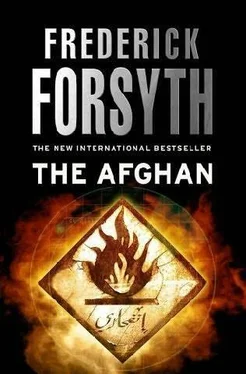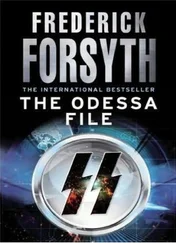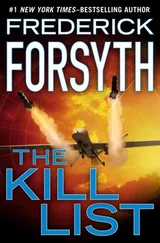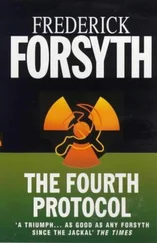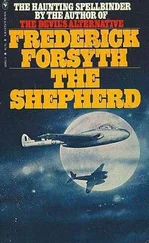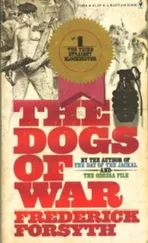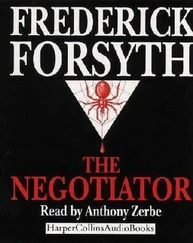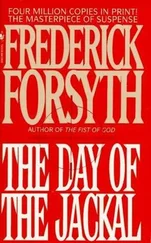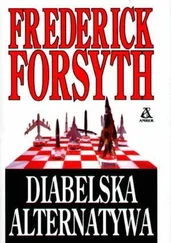The bomb was a J-DAM, a bunker buster, designed to penetrate deep into masonry before exploding. Landing nose down in gravel, it shot forty feet down before going off. The Americans found themselves on top of an earthquake, were hurled around, but survived.
The second mishit was even more unfortunate. It took out the Uzbek tank, and their command post behind it.
By Wednesday, the Western media had arrived and were swarming all over the fort, or at least the outside of it. They may not have realized it, but their presence was the only factor that would eventually inhibit the Uzbeks from achieving a total wipeout of the rebels to the last man.
In the course of the six days, twenty rebels tried to take their chances by escaping under cover of night cross-country. Every one of them was caught by the peasantry and lynched. These were the Hazaras, who recalled the Taliban butchery of their people three years before.
Mike Martin lay on top of the ramp, peering through the parapet and down into the open compound. The bodies from the first days still lay there, and the stench was appalling. The Americans, with their black woolly hats, had uncovered faces and had already been well photographed by cameramen and TV filmmakers. The seven British preferred anonymity. All wore the shemagh, the cotton wraparound headdress that keeps out sand, dust, flies and gawkers. By Wednesday it served another purpose: to filter the stink.
Just before sundown, the surviving CIA man, Dave Tyson, who had come back after a day in Mazar-e- Sharif, was bold enough to enter the compound with a TV crew desperate for an award-winning movie. Martin watched them creeping along the far wall. Marine J was lying beside him. As they watched, a snatch squad of rebels came out of an unseen door in the wall, seized the four Westerners and dragged them inside.
“Someone ought to get them out of there,” remarked Marine J in a conversational tone. He looked round. Six pairs of eyes were staring at him without a sound. He uttered two intensely sincere words-“Oh, shit”-vaulted the wall, went down the inner ramp and raced across the open space. Three SBS men went with him. The other two and Martin provided sniper cover. The rebels were by now confined to the south wall only. The sheer daftness of what the four Marines had done caught the rebels by surprise. There were no shots until they reached the door in the far wall.
Marine J was first in. Hostage recovery is practiced and practiced by both SAS and SBS until it is second nature. At Hereford, the SAS have “the death house” for little else; at their Poole HQ_ the SBS have the same. The four SBS men came through the door without ceremony, identified the three rebels by their clothes and beards and fired. The procedure is called “double tap”: two bullets straight in the face. The three Arabs did not get off a shot; anyway, they were facing in the wrong direction. David Tyson and the British TV crew agreed then and there never to mention the incident, and they never have. By Wednesday evening. Izmat Khan realized he and his men could not stay aboveground any longer. Artillery had arrived, and down the length of the compound it was beginning to reduce the south face to rubble. The cellars were the last resort. The surviving rebels were down to under three hundred. Some of these decided not to go belowground but to die under the sky. They staged a suicidal counterattack that succeeded for a hundred yards, killing a number of unwary Uzbeks with short reaction times. But then the machine gun on the Uzbeks’ replacement tank opened up and cut the Arabs to pieces. They were mostly Yemenis with some Chechens.
On Thursday, on American advice, the Uzbeks took barrels of diesel fuel brought for their tank and poured it down conduits into the cellars below. Then they set fire to it.
Izmat Khan was not in that section of the cellars, and the stench of the bodies overrode the smell of the diesel, but he heard the whoomf and felt the heat. More died, but the survivors came staggering out of the smoke toward him. They were all choking and gagging. In the last cellar, with about a hundred and fifty men around him, Izmat Khan slammed and bolted the door to keep out the smoke. Beyond the door, the hammering of the dying became fainter and finally stopped.
Above them, the shells slammed into the empty rooms. The last cellar led to a passage and at the far end the men could smell fresh air. They tried to see if there was a way out, but it was only a gutter from above. That night, the new Uzbek commander, Din Muhammad, hit upon the idea of diverting an irrigation ditch into that pipe. After the November rains, the ditch was full and the water in it icy. By midnight, the remaining men were waist-deep in water. Weakened by hunger and exhaustion, they began to slip beneath the surface and drown.
Up on the surface, the United Nations was in charge, surrounded by media, and their instructions were to take prisoners. Through the rubble of the collapsed buildings above them, the last rebels could hear the bullhorn ordering them to come out, unarmed and with hands up. After twenty hours, the first began to stagger toward the stairs. Others followed. Defeated at last, Izmat Khan, the last Afghan left alive, went with them.
Up on the surface, stumbling over the broken stone blocks that had once been the south face, the last eighty-six rebels found themselves facing a forest of pointed guns and rockets. In the daylight of Saturday dawn, they looked like scarecrows from a horror film. Filthy, stinking, black from cordite soot, ragged, matted, bearded and hypothermic, they tottered and some fell. One of these was Izmat Khan.
Coming down a rock pile, he slipped, reached out to steady himself and grabbed a rock. A chunk came away in his hand. Thinking he was being attacked, a nervous young Uzbek fired his RPG.
The fiery grenade went past the Afghan’s ear into a boulder behind him. The stone splintered, and a piece the size of a baseball hit him with devastating force in the back of the head.
He was wearing no turban. It had been used to bind his hands six days earlier and never recovered. The rock would have pulped the skull if it had hit at ninety degrees. But it ricocheted off, slicing the scalp and knocking him into a near coma. He fell in the rubble, blood gushing from the gash. The rest were marched away to trucks waiting outside.
An hour later, the seven British soldiers were moving through the compound, taking notes. Mike Martin, as senior officer, although technically the unit interpreter, would have a long report to make. He was counting the dead, though he knew there were scores-maybe up to two hundred-still underground. One body interested him. It was still bleeding. Corpses don’t bleed. He turned the scarecrow over. The clothing was wrong. This was Pashtun dress. There were not supposed to be any Pashtun present. He took his shebagh from his head and wiped the grime-smeared face. Something vaguely familiar. When he took out his Ka-bar, a watching Uzbek grinned. If the foreigner wanted to have some fun, why not? Martin cut into the pant leg of the right thigh. It was still there, puckered with the six stitches, the scar where the Soviet shell fragment had gone in over thirteen years before. For the second time in his life, he hoisted Izmat Khan over one shoulder in a fireman’s lift and carried him. At the main gate, he found a white Land Rover with a United Nations insignia on it.
“This man is alive but injured,” he said. “He has a bad head wound.”
Duty done, he boarded the SBS Land Rover for the drive back to Bagram. The American trawl team found the Afghan in Mazar Hospital three days later and claimed him for interrogation. They trucked him to Bagram, but to their own side of this vast air base, and there he came to two days after that, slowly and groggily on the floor of a makeshift cell, cold and shackled but just alive. On the fourteenth of January 2002, the first detainees arrived at Guantanamo Bay, Cuba, from Kandahar. They were blindfolded, shackled, hungry, thirsty and soiled. Izmat Khan was one of them.
Читать дальше
